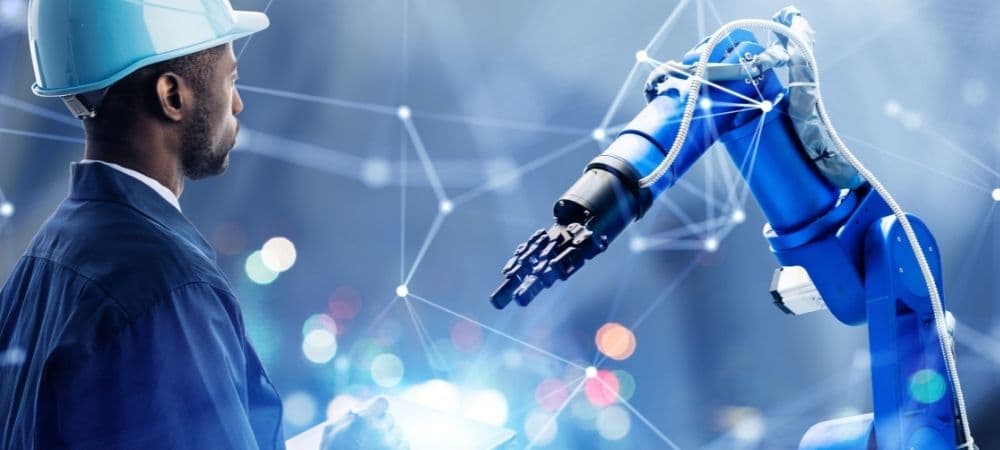Robots are moving into the business world in a big way. There are already
2.7 million industrial robots in use, and the cost to use these machines is coming down, even as functionality goes up. New ideas like RaaS (robots as a service) are letting SMBs leverage the exciting productivity boosts robots can provide.
Thanks to breakthroughs in robotics like new sensor tech and AI, modern companies are seeing big jumps in productivity and earning power. Let’s take a look at how easier-to-use, human-friendly industrial robots, healthcare robots, and humanoid robots have cracked open new efficiency and ROI.
The robot technology surge
Falling sensor prices, rising human labor costs, the advance of tech in general, and rapidly increasing processing power have created a perfect storm of tech. That perfect storm may soon make robots as ubiquitous as computers suddenly were in the 1990s. This will change our workflows and the business world in countless ways, many of which are difficult to predict.
Even 5 years ago, the cost of industrial robots was prohibitive. Most SMBs simply couldn’t afford the
six-figure price tags on workplace robots. Robot costs have
shrunk considerably, often to the $4,000 to $20,000 range with used options even cheaper than that.
Industrial robotics automation
Traditionally, the cost and complexity of programming have kept robotics in manufacturing from helping SMBs. Industrial robots have been challenging to control, requiring massive investments of time and skilled labor to set up and maintain. Today, achieving production line automation with industrial robots is easier for a couple of reasons.
Improved ease of use
Today’s industrial robots are easier to use. Visual programming software lets programmers control robots with simpler graphical interfaces. Off-the-shelf modules provide a robust level of plug-and-play capability.
Better AI and sensor technology
Improved
AI and sensor tech are giving industrial robots the ability to be aware of their environment. They can make better decisions about such things as speed and movement, in the same way that we’ve seen ABS systems stop cars with more skill on slick surfaces than human drivers. Or how self-driving cars can master ever-more difficult driving tasks.
When a robot can “see” with 3D vision and “feel” with a sense of touch, the result is higher productivity and efficiency with less downtime and easier maintenance. One example is the
Boston Dynamics Stretch, which uses human-like senses to work with human-like precision.
Why use robots in manufacturing?
Large businesses have used robots to increase productivity, lower costs, shorten production times, and increase quality measures for decades. Today, smaller businesses have ever-greater access to several types of robots.
What are the different types of industrial robots?
There are several key types of manufacturing robots used in engineering and production:
- Cartesian robots work on three sliding axes, somewhat like a complex printer head. They’re used in 3D printers and CNC machines. They are also known as gantry robots.
- Scara is an acronym for a “selective compliance assembly robot arm” that uses three-axis motion to perform assembly and palletizing jobs.
- Cylindrical robots combine one rotary joint and one prismatic (sliding) joint to assist with assembly or machine tending.
- Articulated robots use the familiar arm and joint configuration, with four-to-six-axis mobility. They’re used in machine tending, material handling, packaging, and assembly.
- Polar robots use one jointed arm connected to a base, and are often used in injection molding, die casting, and welding.
- Delta robots are ideal for high-speed picking and placing applications, using three arms connected to a joint at the base.
- Collaborative robots (or “cobots”) are used for picking, placing, machine tending, and palletizing. They’re designed to coexist with human workers in the same workspace.
Robots as a service (RaaS)
Pay-as-you-go setups like big data as a service (BDaaS) and software as a service (SaaS) have smoothed access to resources previously dominated by large companies.
Robots as a Service (RaaS) lends industrial robotics automation to smaller firms, unfettering both robot hardware and cloud-based robot programming without the pains of outright ownership.
With RaaS, acquisition and maintenance costs are someone else’s problem, as are the massive technical costs of programming and development. To simplify, there are two types of RaaS.
RaaS coding
The first RaaS type lands on the pure coding and control spectrum. In other words, your company may own one robot or several, but you may be unable to afford the costs of programming and coding to control the robots.
In that case, services like
Microsoft Robotics and the
AWS RoboMaker take the grunt work out of the process. They aim to do for robotics what content management platforms like WordPress did for web publishing.
RaaS hardware
For physical hardware, companies like
FetchRobotics and
InViaRobotics offer on-demand industrial robotics automation. They hire out both robots and control systems to let SMBs dip into the productivity gains without having to purchase.
Cobalt Robotics even offers an on-demand robot security force to patrol and guard your premises and inventory. Cobalt claims their security robots cost less than half the price of a human security service.
Trends for industrial robots
Many industries have tasks that robots can perform. Some have been relying on robotics for decades, while others are exploring the newest adaptations to increase productivity and safety.
Healthcare robotics
Surgical robots that let surgeons perform more accurate, minimally-invasive procedures are no longer the stuff of science fiction. Medical students today train on
healthcare robots to perform coronary artery bypasses, hip replacements, gallbladder removal, and
dozens of other procedures.
Surgical robots
Non-surgical healthcare robots
Non-surgical healthcare robots, like exoskeletons for stroke patients and the
human care robots under development in Japan, are also jumping into the medical world. Hospital robots can
deliver specimens and medications using built-in maps and onboard sensors, complete with elevator control via WiFi.
Humanoid robots
Mobile robots that can do anything people can do are coming, in both
humanoid and
caninoid form. We’ve all seen the Boston Dynamics “Spot” robot, designed to move and (to an extent) look like a furry four-footed friend. But they won’t stop at getting featured in cute, or sometimes ominous, YouTube videos.
With an average runtime of 90 minutes, Spot can go almost anywhere a person can. It can also repel rain and dust, and perform simple tasks. Used by an SMB, it may deliver boxes from human-driven or automated vehicles, fulfill security or warehouse logistics needs, or work as a courier robot in a brick-and-mortar facility. Thanks to an expanded degree of freedom, they can work right alongside us, performing similar tasks.
Machine learning
One of the biggest challenges of business robotics even 10 years ago was GIGO (garbage in / garbage out). It used to take an incredible amount of time and effort to tell a robot to perform a simple action. The robot then performed that action regardless of its real-world environment.
Thanks to
massive investments by information technology robotics firms, the landscape is changing. Increasingly, robots can make use of machine learning to
learn a new process quickly. AI and machine learning can help robots make better use of computer vision,
learn almost like a human does, and even adapt to changing conditions in the environment.
Industrial Internet of Things (IIoT)
The
Internet of Things (IoT) has been around for a while. It’s the idea that a growing mass of sensors in the real world (21 billion and growing) are now connected to the internet. Those things bring the real world online and online functionality into the brick-and-mortar world. The
industrial internet of things (IIoT) is an extension of that capability.
Rapidly shrinking sensor costs and better connectivity mean increased production line precision and predictive maintenance, along with a deeper understanding of production at a higher level. That gives top management a fuller sense of what’s really happening on the floor, and ultimately, more control over the process.
IIoT can help robots integrate more smoothly into a process thanks to increased precision, efficiency, and interaction with their surroundings. It can also ramp up predictive maintenance, lowering overall costs. The IIoT has created a new approach to robotics in the IT industry.
Lower costs, expanded capabilities
We’re experiencing a sea change in industrial robotics as costs plummet for all related technologies. The change is similar to the price drop in computers that had everyone suddenly using the term “personal computer” when that term was a shocking concept. Before the advent of microcomputers, computers were machines that filled whole rooms and were owned by universities, governments, or major corporations.
Collaborative robots
These finally accessible robots can perform assembly, machine tending, material handling, welding, and other actions. They’re also flexible enough to be moved from one process to another with minimal retraining. For instance, the
Universal Robots Cobot can learn a new task in just a few hours.
Collaborative robots on the whole are one of the most exciting small business robotics applications. They’re both affordable and safe around humans, plus they’re extremely flexible and offer quicker ROI and profitability.
Summary
We live in a heady time for small business and robotics. Thanks to converging and emerging tech like lowering sensor costs, machine learning, AI, and robot mobility, industrial robotics are becoming more accessible by the day. Robots today are smaller, quicker to set up, more affordable, safer, and able to work in close collaboration with a human workforce. Combined with options like RaaS and the IIoT, we’re entering a brave new world of productivity and ROI.
About the Author: Tom Gerencer is a contributing writer for HP Tech@Work. Tom is an ASJA journalist, career expert at Zety.com, and a regular contributor to Boys' Life and Scouting magazines. His work is featured in Costco Connection, FastCompany, and many more. Popular HP Business Computers



















